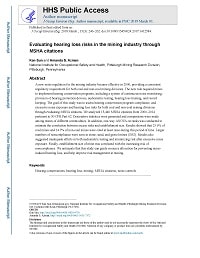Mining Publication: Evaluating Hearing Loss Risks in the Mining Industry Through MSHA Citations
Original creation date: March 2018
Authors: K Sun, A Azman
A new noise regulation for the mining industry became effective in 2000, providing a consistent regulatory requirement for both coal and non-coal mining divisions. The new rule required mines to implement hearing conservation programs, including a system of continuous noise monitoring, provision of hearing protection devices, audiometric testing, hearing loss training, and record keeping. The goal of this study was to assess hearing conservation program compliance, and excessive noise exposure and hearing loss risks for both coal and non-coal mining divisions through evaluating MSHA citations. We analyzed 13,446 MSHA citations from 2000–2014 pertinent to 30 CFR Part 62. Descriptive statistics were generated and comparisons were made among mines of different commodities. In addition, one-way ANOVA on ranks was conducted to estimate the correlation between excess risks and establishment size. Results showed that 25.6% of coal mines and 14.7% of non-coal mines were cited at least once during this period of time. Larger numbers of noncompliance were seen in stone, sand, and gravel mines (SSG). Results also suggested inadequate efforts in both audiometric testing and minimizing risk after excessive noise exposure. Finally, establishment size of mine was correlated with the increasing risk of noncompliance. We anticipate that this study can guide resource allocation for preventing noise-induced hearing loss, and help improve risk management in mining.

- Development and Evaluation of a Urethane Jacketed Tail Roller for Continuous Mining Machines
- Noise and Hearing Protection: Development of Two Training Exercises for Drillers
- Noise Exposure in Longwall Mining and Engineering Controls Research
- Noise Source Identification on a Continuous Mining Machine
- Noise Source Identification on a Horizontal Vibrating Screen
- Snapshot of Noise and Worker Exposures in Sand and Gravel Operations
- A Technique for Estimating the Sound Power Level Radiated by Pneumatic Rock Drills and the Evaluation of a CSIR Prototype Rock Drill with Engineering Noise Controls
- Water Well Safety Bits: Health And Safety Information For The Water Well Industry
- What Does a Hearing Loss Sound Like?
- Working in Noise with a Hearing Loss: Perceptions from Workers, Supervisors, and Hearing Conservation Program Managers